As I’ve been whittling away at the trip photos and video, I’ve still been out getting current photos – I’ve just been setting most of them aside. So we’ll play catch-up a little here, concentrating on the avians this time around.
On the same day that I snagged the angry bird, I got a couple of others in the immediate vicinity, which means at the neighborhood pond. I would have missed this one entirely if it hadn’t attracted my attention.
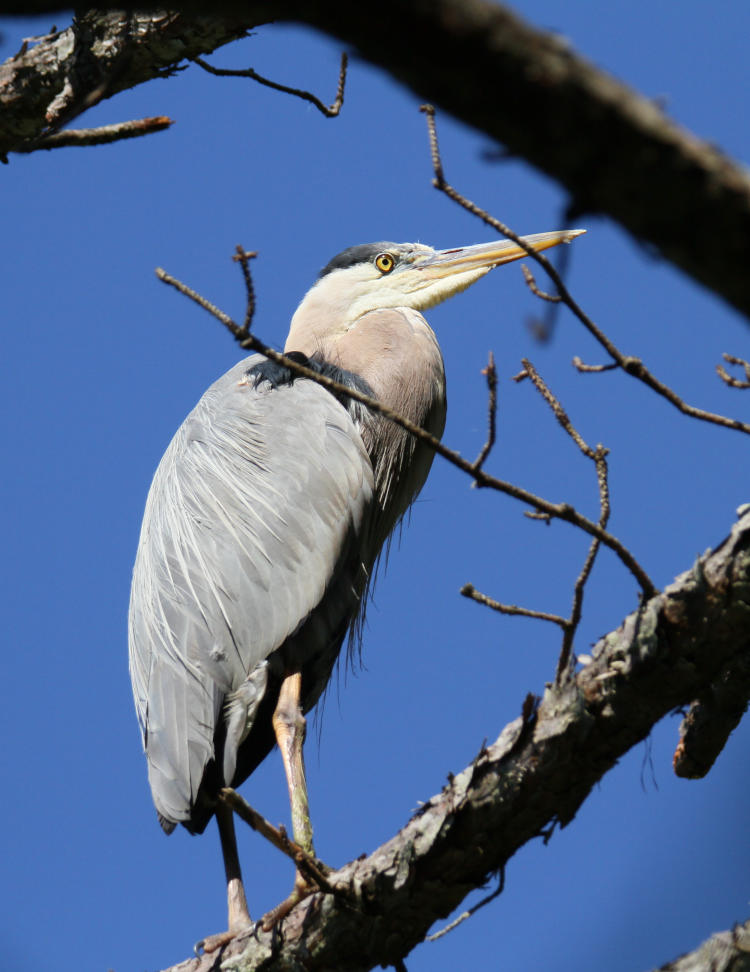
This great blue heron (Ardea herodias) was hidden from view until I was almost directly underneath, not to mention that I was watching the pond edges for the green herons and snakes, but I was forced to look up by some soft grunts, which I can only assume were purposeful, though whether this was a half-hearted warning to me or simply commentary on my bald spot, I cannot say. Regardless, the heron stayed put as I passed underneath, which was almost startling given how spooky the herons have been over there for the past year or so, and descended down to the water’s edge to fish once I had gotten a safe distance away.
But we need a detail inset of another frame.
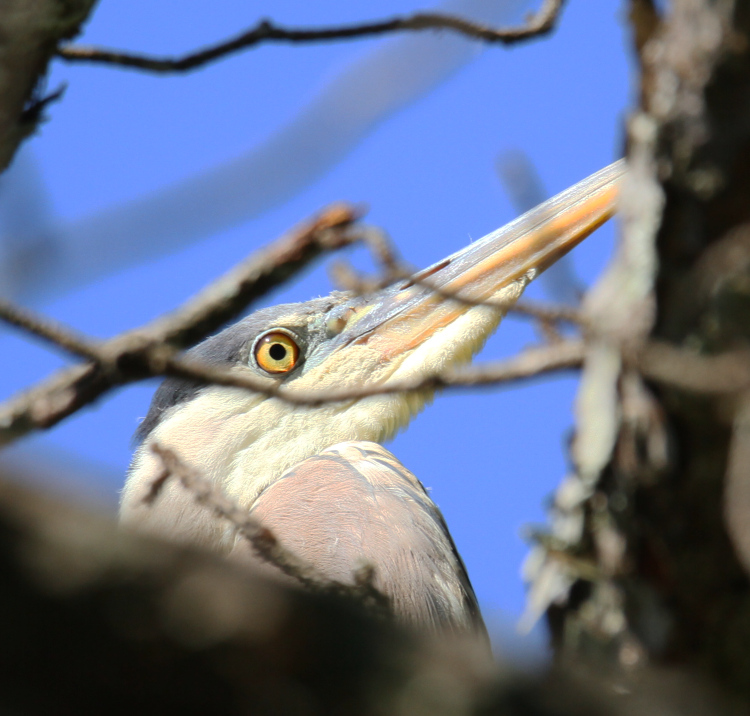
It’s a shame about the twigs, but this was one of the few gaps in the trees that allowed an unobstructed view, and I could at least dodge a little to get the eye clear. We’re talking somewhere around 10-12 meters distant, so, not far at all.
I mentioned the angry bird in there, so here’s a photo from a slightly different angle, before I managed to get head-on, just to illustrate – the heron really was crouched with neck fully tucked, relying on being motionless to avoid my attention. Ha! Like that ever works!

[Actually, it may work an awful lot, and I’m just incapable of telling you how often.] Not the sharpest pic, but of course, once I saw the other, that had to be the one used (I’m gonna force you to click on that link if you haven’t already.) This heron was not quite directly underneath the great blue, being on the opposite side of a narrow channel, but they were within easy sight of one another, and I have their photos intermixed in the folders because I was switching back and forth between the two subjects.
A little further on, I glanced into a bluebird box affixed to a tree and thought I saw a shape in the shadows, so I fired off a couple of frames. This one’s enhanced slightly.

I’ve already seen the parents feeding young in this box, so either it’s one of the juveniles peeking out (because the parents only stay in the box after hatching to keep the young warm, which wasn’t necessary this hot day,) or they’ve already moved out and a second brood has been laid therein by another couple. I admit to not inquiring – it always seems nosy.
We’re going roughly in chronological order here, so now we jump many kilometers away. Crossing a branch of Jordan Lake a few weeks ago, I looked over to the side and saw what I took to be (judging from the size) an eagle’s nest, and could have sworn I saw a white head peeking out. Several days later, Buggato and I made the trip down there to get a better look than driving past in a car (I was not driving for that initial view.)

Morning was not the time to do this, since we were aiming too much into the sun and it washed out all of the color and contrast, but at least it was enough to see that it was an osprey (Pandion haliaetus) nest and not an eagle’s – though the osprey may have appropriated an abandoned eagle’s nest, because it seems kinda big for osprey, to me. Its behavior indicated that it was sitting on eggs, and so I vowed to return to keep an eye on things, even though, from this angle, there would be little to see until the young get to be decent-sized, but I might get lucky enough to see some fledging behavior.
It was just over a week before I returned, this time in the afternoon with The Girlfriend, so the light was better but, as yet, no sign of hatching.
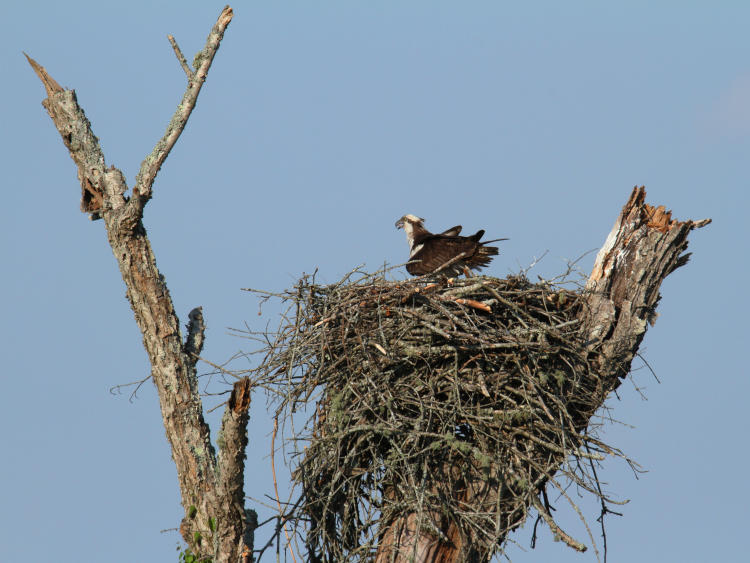
I’m not identifying this as a female, because the genders are identical and I’m not sure if the male takes turns warming the eggs; either way, this one spent a lot of time standing, fluffed out a bit, but it was a hot day so I imagine the eggs did not need constant body warmth. It’s also possible that the eggs had hatched, and Spouse 1 was waiting for Spouse 2 to arrive with more food. The region, a stump farm created by the flooding of the manmade lake, held more than one osprey nest and was overflown with other osprey, eagles (we spotted a distant juvenile,) herons, and crows, so it’s not unreasonable to expect a parent to remain in attendance for protection. Let’s have a closer look though.
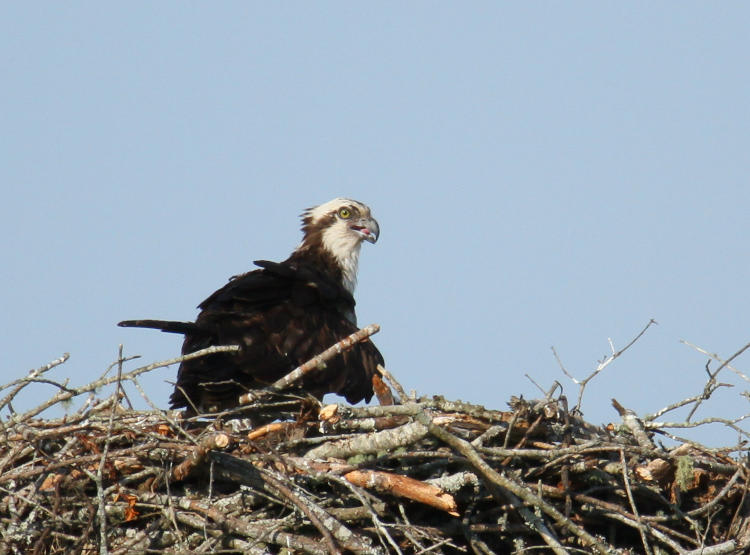
We were a decent distance off, so no immediate threat at all, but we could still hear the osprey venting some faint cries. They do this often, especially on the nest, so it might also be a signal to the mate or warnings to any other birds in the vicinity – I can’t confirm or deny that they were about us, over on the bridge, but in this case the osprey sure looks like it’s eyeing us directly. We’ll see what develops with the young.
Okay, back to the neighborhood. A heron – whether it’s the same one or not I can’t say, because I’m not a spoiler – landed in some trees ahead and I slipped in for a couple of shots through the foliage, catching it panting in the heat before it flew off at my approach.

I mentioned earlier that this year has shown us the coldest May that I’ve experienced since moving south, and then we went into sweltering temperatures – it was about 32°C that day. And now, as I type this, it’s dropped below 16°. Enough already. But we got our overdue rains at least, filling up the nearly-empty rain barrels, so that’s good.
A pair of green herons played chase over the pond, the same day as the heron shot above.
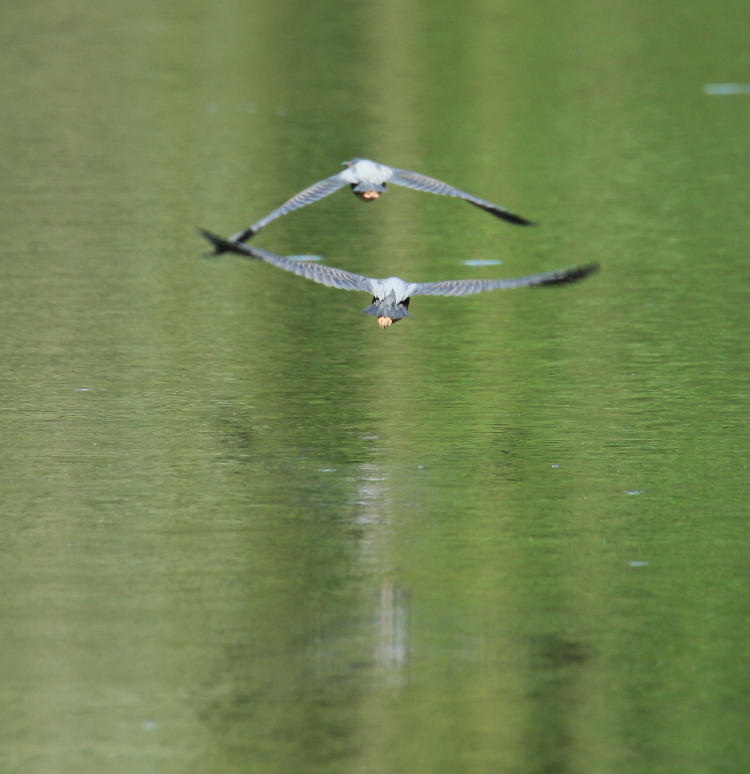
I just missed getting them mirroring one another, almost perfectly aligned; there’s no way you can anticipate or time this with them wheeling in circles, and I’m lucky to get the focus this good because none of the other frames came out worth a damn.
A day later, I did even more birds – lucky you. You may recognize these from Blurred Bird Day.
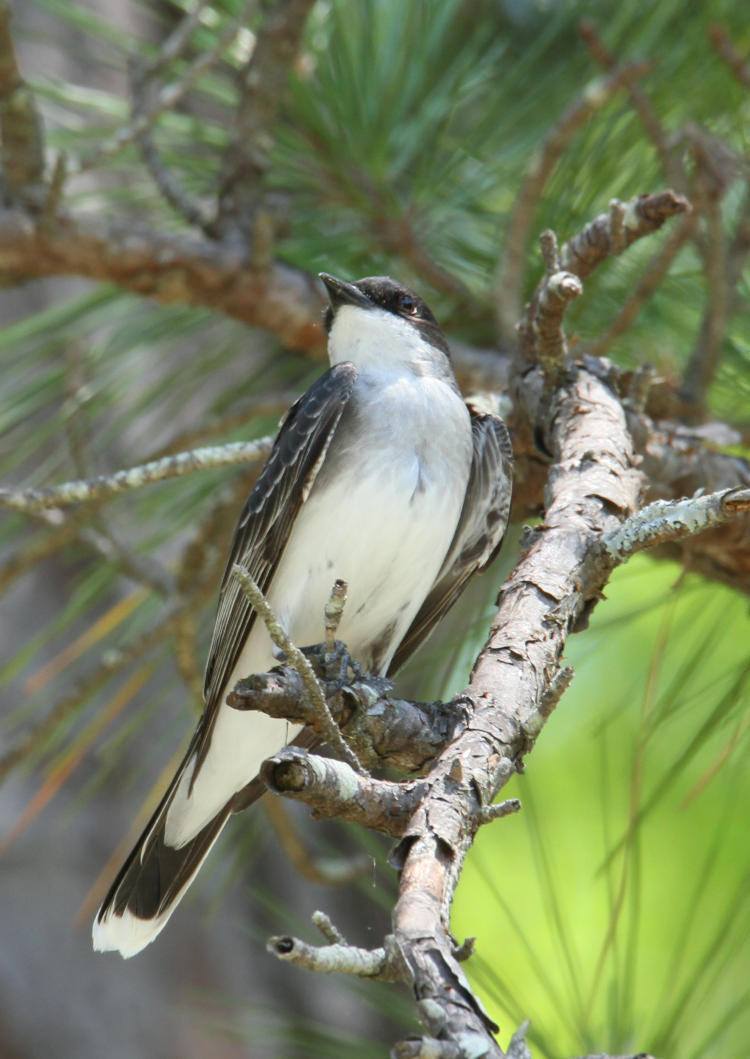
An eastern kingbird (Tyrannus tyrannus) provided a pose, I’m almost certain after it flew away from the nest. It’s possible this is intentional protective behavior, the contrasting coloration attracting attention as they fly away from the young, but remain close enough to keep an eye on things. Or maybe it saw the camera and is just vain.
You know, I’m glad my bird guide lists the various species under, for instance, ‘kingbird,’ and not, ‘eastern,’ because that would take forever to look up – ‘eastern’ appends a ridiculous number of species around here. The people involved in taxonomy need more creativity, and possibly a thesaurus.
Further on, a juvenile downy woodpecker (Dryobates pubescens) caught my eye.
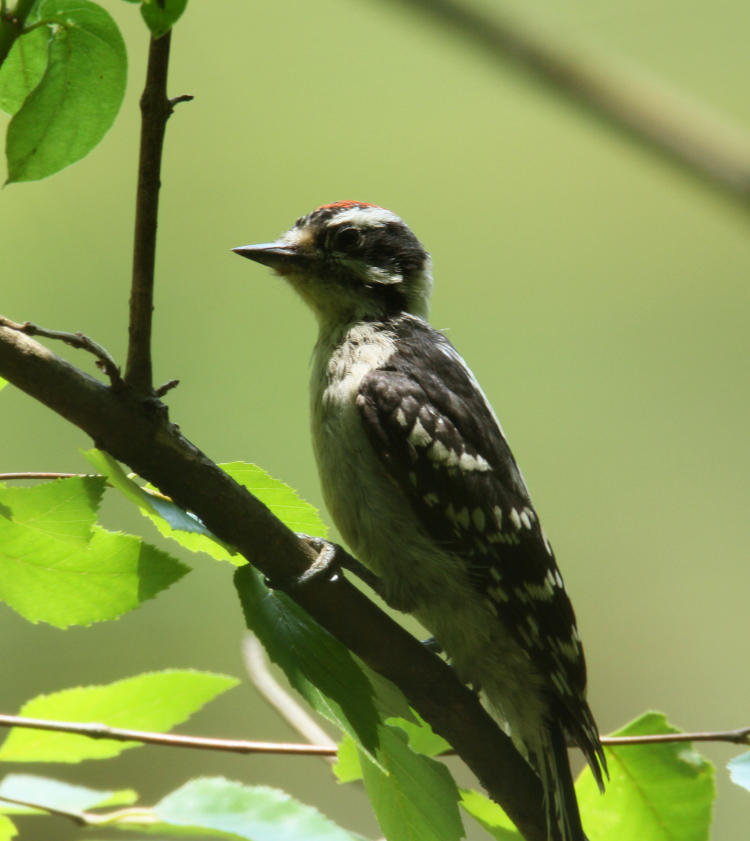
This one never made the faintest sound as it foraged, down low near the water’s edge which is far from typical, so I was lucky to see it moving when it was close. The lower light, however, did not play well with the hyperactivity of the woodpecker family, so it was a struggle to catch it while it paused long enough not to induce motion blur. It still had a little bit of a mangy, threadbare appearance, so I knew it wasn’t long out of the nest.
By the way, this is why bird guides can be slightly misleading; in the time since my copy of Sibley’s Guide was printed, the genus changed from Picoides to Dryobates. I have to double-check when doing these posts (though I don’t always do so.)
The Girlfriend had accompanied me on this outing, and we’d stopped to talk to a friend. While there, we heard the call of a pileated woodpecker (Dryocopus pileatus,) which our friend informed us was hanging around in the area. Shortly afterward, The Girlfriend spotted it poking animatedly down among the ground litter.

Pileateds aren’t ground or leaf foragers, but you can see the fallen, rotting limb that it was working on. The view was terrible, the bird obscured until it raised its head, which it did for no more than .3 seconds at a time. I want to show you the full-frame, initial view.
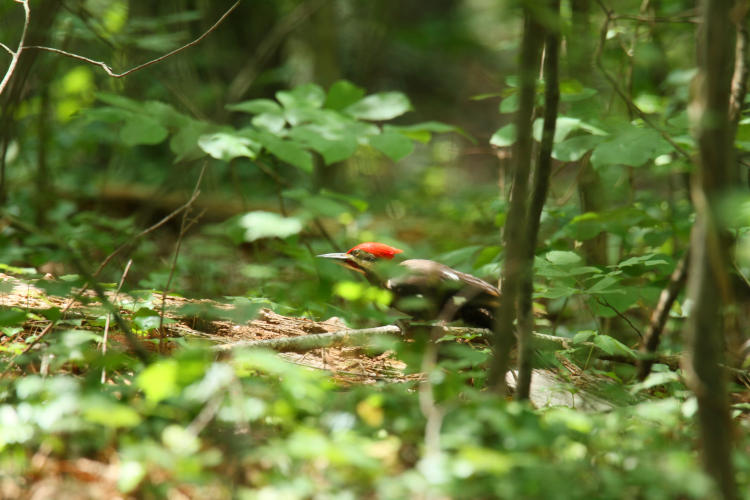
Bearing in mind that this was 600mm, so without a long lens, mostly what was visible was the red head bobbing up occasionally.
I started working my way around carefully, being lucky enough to have a path strewn with wood chips running alongside the woodpecker, and a large tree that obscured his view of me until I drew close (this is definitely a male, from the amount of red feathers on the head – the female’s red feathers do not reach the beak.) Then I leaned out slowly and had a much better vantage, though the sound of the shutter made him aware that I was close.

He kept a wary eye on me but continued foraging, not too spooked as long as I didn’t move much. Pileateds are bigger woodpeckers, not quite as large as a crow, compared to the downy which is about the size of a bluebird.
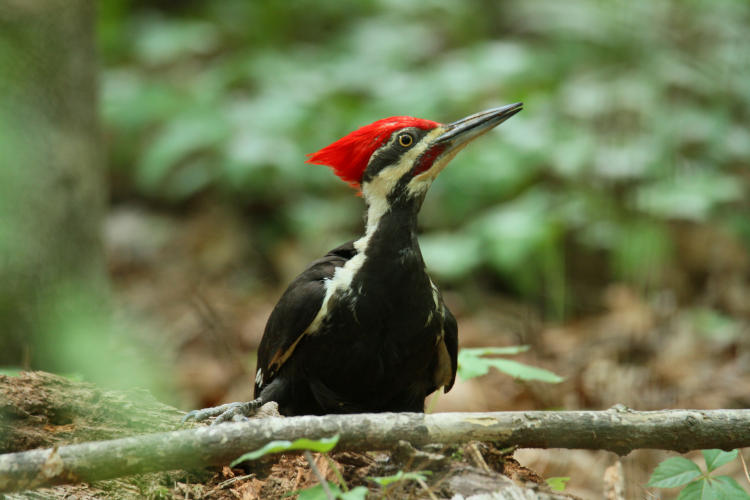
This is again full-frame, showing what kind of view I had – I was less than eight meters off. Note the leg sticking out there to the left; woodpeckers are tree-clingers, not ground perchers, plus they need the bracing of the tail to peck vigorously, so it’s an awkward position here. Now let’s go in for the detail.
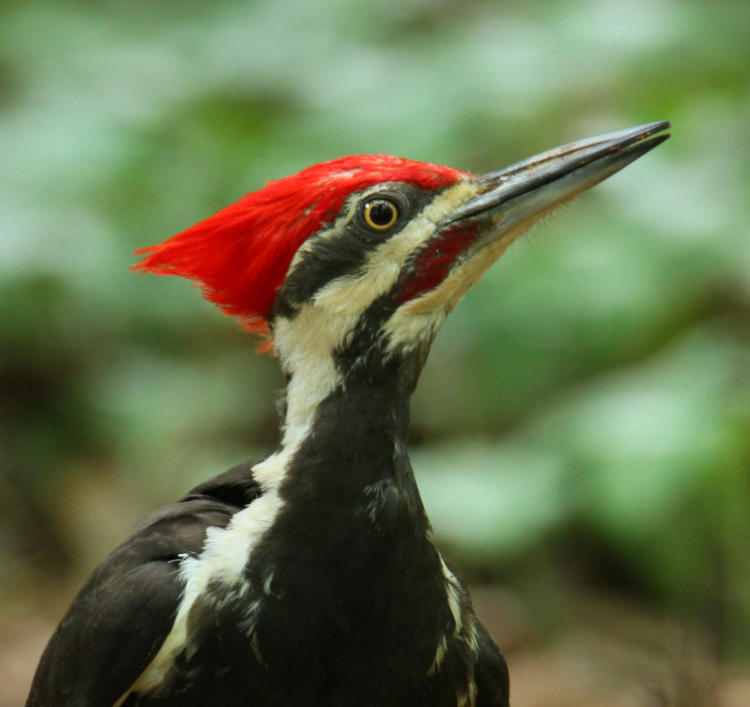
I’m not knocking that at all, and editing this photo made me aware that pileateds have the reddest feathers that I’ve ever seen, far beyond cardinals, almost unreal – if I found a head feather in the woods, I might have been convinced that it was some dyed, decorative thing rather than their natural coloration. This will become a print someday.
That catches us up, at least for the birds. Some other subjects are coming later on.




















































